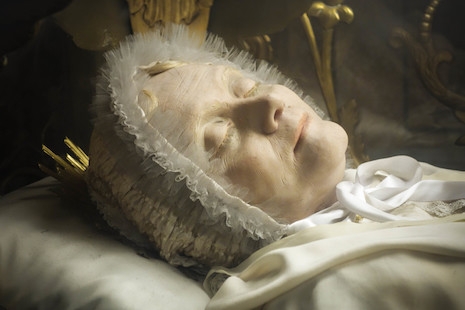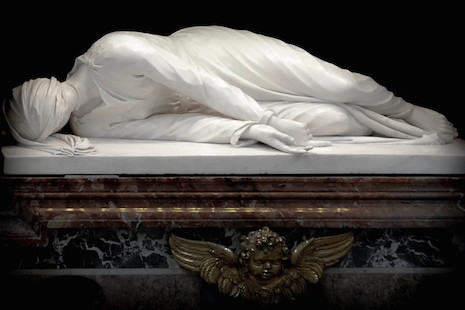
The incorrupt body of Blessed Anna Maria Taigi, wax portraiture over bone, San Crisogono, Rome.
For many in our empirical and rational age, the belief in miracles and saints that is an accepted part of Catholic doctrine might present something of a challenge. As a species we now understand enough of the natural world to be able to send men to the moon, while the shelves of any pharmacy seem to establish much the same premise, that secular science, let’s say, might prevail over prayer. Paradoxically, the apparent dominance of science in our lives has the effect of making belief in miracles and saints that much more powerfully a test of faith.
This brings us to Elizabeth Harper’s fascinating photographs of the bodies of “incorrupt” saints. There is a group of saints whose special status is emphasized by the fact that their bodies refuse to decompose. The allure of such an idea is easy enough to imagine—the purity of a person’s soul reflected in some magical ineffability of the body. Bad people ought to stink more after they die, right? It makes a weird kind of intuitive sense. Unfortunately, the facts of nature don’t play along.
The secular mind rejoices when Dostoevsky reveals in The Brothers Karamazov that the body of the pious and wise Father Zossima stinks just as bad as everyone else’s:
The fact is that a smell of decomposition began to come from the coffin, growing gradually more marked, and by three o’clock it was quite unmistakable. In all the past history of our monastery, no such scandal could be recalled, and in no other circumstances could such a scandal have been possible, as showed itself in unseemly disorder immediately after this discovery among the very monks themselves. Afterwards, even many years afterwards, some sensible monks were amazed and horrified, when they recalled that day, that the scandal could have reached such proportions. For in the past, monks of very holy life had died, God-fearing old men, whose saintliness was acknowledged by all, yet from their humble coffins, too, the breath of corruption had come, naturally, as from all dead bodies, but that had caused no scandal nor even the slightest excitement. Of course, there had been, in former times, saints in the monastery whose memory was carefully preserved and whose relics, according to tradition, showed no signs of corruption. This fact was regarded by the monks as touching and mysterious, and the tradition of it was cherished as something blessed and miraculous, and as a promise, by God’s grace, of still greater glory from their tombs in the future. (Translation by Constance Garnett)
Like the man says: “There had been, in former times, saints ... whose relics, according to tradition, showed no signs of corruption.”
If you go to Rome you can actually pay a visit to a bunch of these incorrupt saints, and recently photographer Harper did just that and came away with a lot of interesting new work. The difficulty of sustaining a belief in incorruptibility as the pitiless centuries grind onward and onward leads to the existence, around the displayed bodies of these saints, of what nonbelievers might term “shenanigans.” But maybe it isn’t so simple—maybe the people in charge of these bodies aren’t so simple, either.
For instance, sometimes the preservation of the incorrupt is (it is claimed) intended to be perceived. The sacristan who was overseeing the sacred relics of Anna Maria Taigi insists that the wax on her body is not there to trick the devout; the intent is to preserve an honest impression of her body in the moment she was discovered in her grave. Meanwhile, St. Paula Frassinetti was given a bath in carbolic acid to assist in the preservation of her body. Pope St. Pius V and St. Vincent Pallotti are encased in silver, while St. Catherine of Sienna and St. Cecelia are encased in white marble.
In reality, of course, the corpses generally do decompose, and squaring this with official doctrine (even if it isn’t considered a hard-and-fast rule in the first place) can be a bit tricky. After 133 years, the body of St. Paula Frassinetti at the Convent of St. Dorotea in Rome is shriveled and brown, and Francesca Romana is pretty much a skeleton. According to Heather Pringle, who has led a team of pathologists from the University of Pisa in researching the subject, opening a tomb sometimes disrupts the microclimates that leads to spontaneous preservation, which can affect even the body of a saint.
As Harper writes:
This is surprisingly unproblematic for believers. The Church doesn’t count incorruptibility as an official Vatican-approved miracle anymore. It’s more like a favorable, if fading, sign from God.
Incorruptibility also isn’t binary, something you either are or aren’t. It can affect just one body part, lending extra significance to a heart, a tongue or hand. There are shades and degrees within the ranks of the incorrupt that make their numbers impossible to tally.
The standard account of incorruptible saints is The Incorruptibles: A Study of the Incorruption of the Bodies of Various Catholic Saints and Beatified by Joan Carroll Cruz, a housewife who decided to research and count every incorrupt saint.

The tomb of St. Cecilia, the first incorrupt saint. This famous effigy depicts the position her body was found in. Note the wound in her neck from her martyrdom., Santa Cecilia in Trastevere, Rome.

The wax effigy of St. Carlo da Sezze. His relics are enshrined under the altar behind his effigy, San Francesco d’Assisi a Ripa Grande, Rome.
More after the jump…





